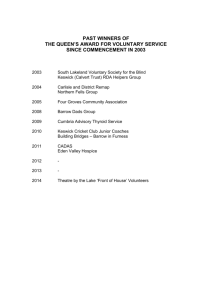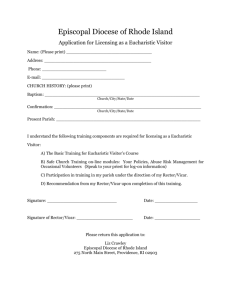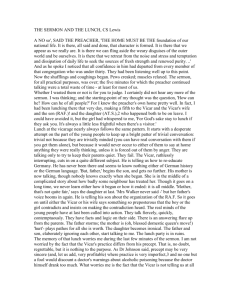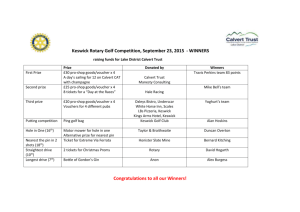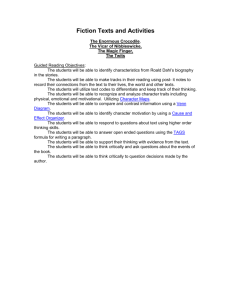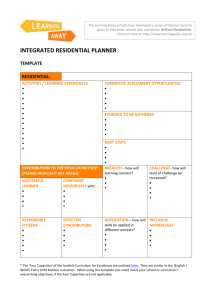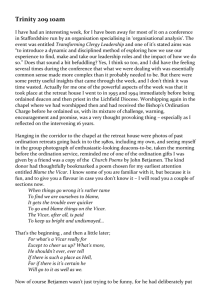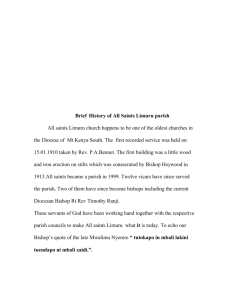Keswick St John History and Clergy
advertisement
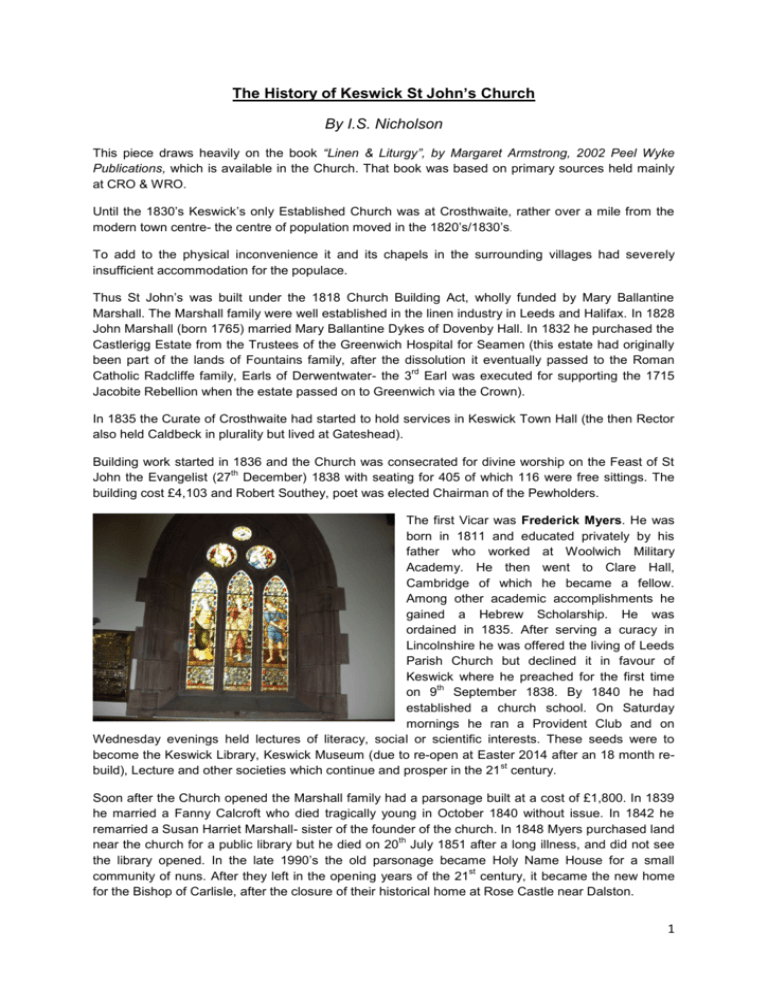
The History of Keswick St John’s Church By I.S. Nicholson This piece draws heavily on the book “Linen & Liturgy”, by Margaret Armstrong, 2002 Peel Wyke Publications, which is available in the Church. That book was based on primary sources held mainly at CRO & WRO. Until the 1830’s Keswick’s only Established Church was at Crosthwaite, rather over a mile from the modern town centre- the centre of population moved in the 1820’s/1830’s. To add to the physical inconvenience it and its chapels in the surrounding villages had severely insufficient accommodation for the populace. Thus St John’s was built under the 1818 Church Building Act, wholly funded by Mary Ballantine Marshall. The Marshall family were well established in the linen industry in Leeds and Halifax. In 1828 John Marshall (born 1765) married Mary Ballantine Dykes of Dovenby Hall. In 1832 he purchased the Castlerigg Estate from the Trustees of the Greenwich Hospital for Seamen (this estate had originally been part of the lands of Fountains family, after the dissolution it eventually passed to the Roman rd Catholic Radcliffe family, Earls of Derwentwater- the 3 Earl was executed for supporting the 1715 Jacobite Rebellion when the estate passed on to Greenwich via the Crown). In 1835 the Curate of Crosthwaite had started to hold services in Keswick Town Hall (the then Rector also held Caldbeck in plurality but lived at Gateshead). Building work started in 1836 and the Church was consecrated for divine worship on the Feast of St th John the Evangelist (27 December) 1838 with seating for 405 of which 116 were free sittings. The building cost £4,103 and Robert Southey, poet was elected Chairman of the Pewholders. The first Vicar was Frederick Myers. He was born in 1811 and educated privately by his father who worked at Woolwich Military Academy. He then went to Clare Hall, Cambridge of which he became a fellow. Among other academic accomplishments he gained a Hebrew Scholarship. He was ordained in 1835. After serving a curacy in Lincolnshire he was offered the living of Leeds Parish Church but declined it in favour of Keswick where he preached for the first time th on 9 September 1838. By 1840 he had established a church school. On Saturday mornings he ran a Provident Club and on Wednesday evenings held lectures of literacy, social or scientific interests. These seeds were to become the Keswick Library, Keswick Museum (due to re-open at Easter 2014 after an 18 month rest build), Lecture and other societies which continue and prosper in the 21 century. Soon after the Church opened the Marshall family had a parsonage built at a cost of £1,800. In 1839 he married a Fanny Calcroft who died tragically young in October 1840 without issue. In 1842 he remarried a Susan Harriet Marshall- sister of the founder of the church. In 1848 Myers purchased land th near the church for a public library but he died on 20 July 1851 after a long illness, and did not see the library opened. In the late 1990’s the old parsonage became Holy Name House for a small st community of nuns. After they left in the opening years of the 21 century, it became the new home for the Bishop of Carlisle, after the closure of their historical home at Rose Castle near Dalston. 1 Th Interestingly Myer’s eldest son, Frederic William Henry Myers (born 1843) died at Rome in January 1901 aged 57, was repatriated and buried at Keswick 4 weeks later. The Myers family tomb is just inside the Churchyard beside the gate to the parsonage, near the Marshall family plots. The photographs show his memorial window and his internal family monument- the small brasses are foe his wife, sons and son’s wives- the large brass is to the son who died in Rome. During his final illness the Parish had been nd looked after by Thomas Dundas Harford Battersby who then became the 2 Vicar. He was born in 1822 the son of a banker. In 1841 he went up to Oxford and the following summer went on holiday to Grasmere where he met Coleridge and William Wordsworth-Poet Laureate. He was deeply impressed by the Oxford Movement-which led him to take Holy Orders in 1847 and he became Curate of Gosport, Hampshire. While torn between Evangelical and Tractarian teaching he read Myer’s books on theology, heard that he was looking for a curate and came to join him, having come down on the Protestant, rather than Anglo-Catholic side. In 1856 the Parish was legally separated from Crosthwaite to be a Parish in its own right. He married a Mary Forbes from Edinburgh in 1854. In June 1875 with a Robert Wilson he held 3 days of “Union Meetings for the Promotion of Practical Holiness” in the Parsonage Grounds. The next month more meetings were held in a tent in Eskin Street. From this small foundation the world famous Keswick Convention grew which even in st the 21 century is still based on that same Eskin Street site. The north aisle was added to the church in 1862 and the south aisle in 1882. Just as the 1883 th convention was about to start he died suddenly on 25 July. A few days later over a thousand people gathered in the convention tent, including over 100 clergy for a procession to the church. He was buried outside the west end of the then new south aisle. Later that year the Revd John N Hoare was rd appointed as the 3 Vicar. In January 1887 he announced plans to extend the chancel and to build an organ chamber. The money for this was raised by public subscription and a Grand Bazaar in August 1888. The new Chancel was opened in July 1889 by the Bishop of Carlisle together with a churchyard extension. 2 th The 4 Vicar in 1900 was Henry Venn Elliot who stayed but three years due to serious illness. He was succeeded in 1903 by H Gresford Jones who left in 1905 to the more exacting and ardous job of Vicar of Bradford. th The 6 Vicar, from December 1906 was Morley L Headlam. In 1910 he attended a Missionary Conference in Edinburgh and the consecration of Dr Walpole as Bishop of Edinburgh. The Bishop’s son, Hugh, became a famous writer, had a home at Derwentwater, regularly worshipped at St. John’s and in due course was buried in the churchyard. In 1912 a new organ was purchased, a new bell cast and new pews provided. In 1917 a side-chapel was built in the North Aisle behind the organ. By 1918 practically all pews were free- the rents having been bought out or relinquished. In August 1918 he moved to Horsham, Sussex. th His successor, Charles Herbert Lewin was instituted on 17 November 1918. He had been ordained for 21 years serving 6 years at Bishop Wearmouth then Gateshead, followed by 9 years in Australia, 3 years on the Diocesan Clerical Staff then 3 years as Vicar of St Paul’s, Hull. In 1921 the west window (the Resurrection window) was installed in memory of Louise Highton, a wartime VAD nurse. In 1922 a further Churchyard Extension below the terrace was consecrated. In 1935 his health began to fail and he left in early 1936. After a long interregnum Herbert Edmund John Mathew arrived in late 1936. He died suddenly playing bowls at Fitz Park in June 1949. He is buried near Frederic Myers in the Churchyard. st th On 1 February 1950 Vorley Michael Spencer Ellis was instituted as the 9 Vicar and was to remain until 1983. He was succeeded by Canon Richard Watson who died suddenly on a pilgrimage to Iona in 1990. The photograph shows his memorial window. He was a noted historian who had begun the book from which these notes are taken. th The 11 Vicar was Nigel Peter Holmes who was at St John’s from 1991 to 1994. He was born in 1948 and educated at Nottingham University. He trained for the ministry at Kelham Theological College. He served his curacies at Barrow-in-Furness St Matthew 1972 to 1975 and Derby St Bartholomew 1975-1978. He was then priest in charge of charge of Great Barlow, Derbyshire 1978-1984 and Vicar of Carlisle St Herbert with St Stephen 1984 to 1991. After leaving Keswick he went to Mexborough, Sheffield to 1997, then Nether Hoyland to 2007 (with Tankersley from 2004) and finally Monk Bretton, Wakefield to 2009 when he retired to Morpeth, Northumberland. His successor was Brian Smith. He was born in 1944. After Oxford University he trained for the ministry at Sarum & Wells Theological College and was ordained in 1974. He served his title at Pennywell with Grindon, Diocese of Durham to 1977 and was then a Chaplain with the RAF to 1995. He then came to Keswick in 1995 and stayed until 2005. During that time he was also Rural Dean of Derwent from 1998 and Honorary Canon of Carlisle Cathedral from 1999. He left to go to the Isle of Man as Archdeacon and also Vicar of Douglas St George where he remains in March 2014. th The 13 and current (March 2014) Vicar of the Parish is Allan Stephen Pye. He was born in 1956. After University College, Lampeter he trained for the ministry at Westcott House, Cambridge. He was ordained in 1981 and served his curacies at Scotforth, Lancaster 1981-1985 then Oswaldtwisle 1985 3 to 1987. He was then Vicar of Wrightington & Chaplain of Wrightington Hospital, Preston to 1991 before moving to Cumbria. Here his first posting was Hayton (near Brampton) from 1991 to 1998 (jointly with Cumwhitton from 1993), and Rural Dean of Brampton from 1996. He has been an Honorary Canon of Carlisle Cathedral since 1997. From 1998 to 2006 he was Vicar of Hawkshead with Low Wray and Sawrey (and Rusland from 2003). He came to Keswick in 2006. 4
